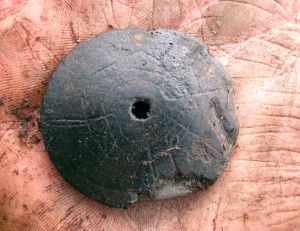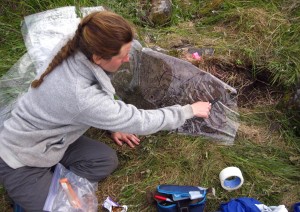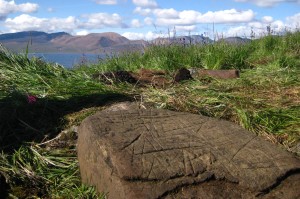Noatak prehistoric site contains new artifacts for Alaska
September 7, 2011

907-474-6941
9/7/11
Archaeologist Scott Shirar expected to find boulders adorned with petroglyphs during his expedition to explore the previously discovered remains of three prehistoric lakefront dwellings in Northwest Alaska’s Noatak National Preserve this summer.
When he and members of his team began small-scale excavations at two of the sites, they made a new discovery: four decorated clay disks that appear to be the first of their kind found in Alaska.
“The first one looks like a little stone that had some scratch marks on it,” said Shirar, a research archaeologist at the University of Alaska Museum of the North. “We got really excited when we found the second one with the drilled hole and the more complicated etchings on it. That’s when we realized we had something unique.”
After sharing information with colleagues and looking up examples in the archaeological record, Shirar said the disks appear to be a new artifact type for Alaska. "We only opened up a really small amount of ground at the site, so the fact that we found four of these artifacts indicates there are probably more and that something really significant is happening."

Mareca Guthrie, fine arts collection manager at the University of Alaska Museum of the North, joined the expedition to make sketches and take tracings of the boulders. At first, she was just excited for an opportunity to get out of the basement of the museum for a week, but she quickly developed an appreciation for the people who had lived there.
“It felt so intimate to be looking through someone else's things, knowing that they sat in the same spot and saw the same view of the mountains. When I started getting tired of the mixed nuts I brought for lunch, I thought, ‘Did the kids complain when they ate caribou day after day or were they thankful to have it?’” she said. “I became so hungry to know more about them, I'm afraid I may have driven the archeologists a little crazy with my questions.”

Archaeologists use the term rock art to describe any human-made marks on natural stone. Petroglyphs are pictures created by picking, carving or abrading the surface of a rock. Shirar said the precise meaning of these petroglyphs, as well as the designs on the clay disks, is still unknown, but their value is clear.
"These objects and places clearly had special significance to their makers. These finds offer an especially tangible reminder of the rich spiritual and intellectual lives they led."
ADDITIONAL CONTACT: Scott Shirar, UA Museum of the North research archaeologist, at 907-474-6819 or via email at sjshirar@alaska.edu.
ON THE WEB: museum.uaf.edu
NOTE TO EDITORS: Images are available for download at www.uafnews.com.
TB/9-7-11/055-12


